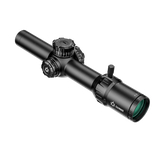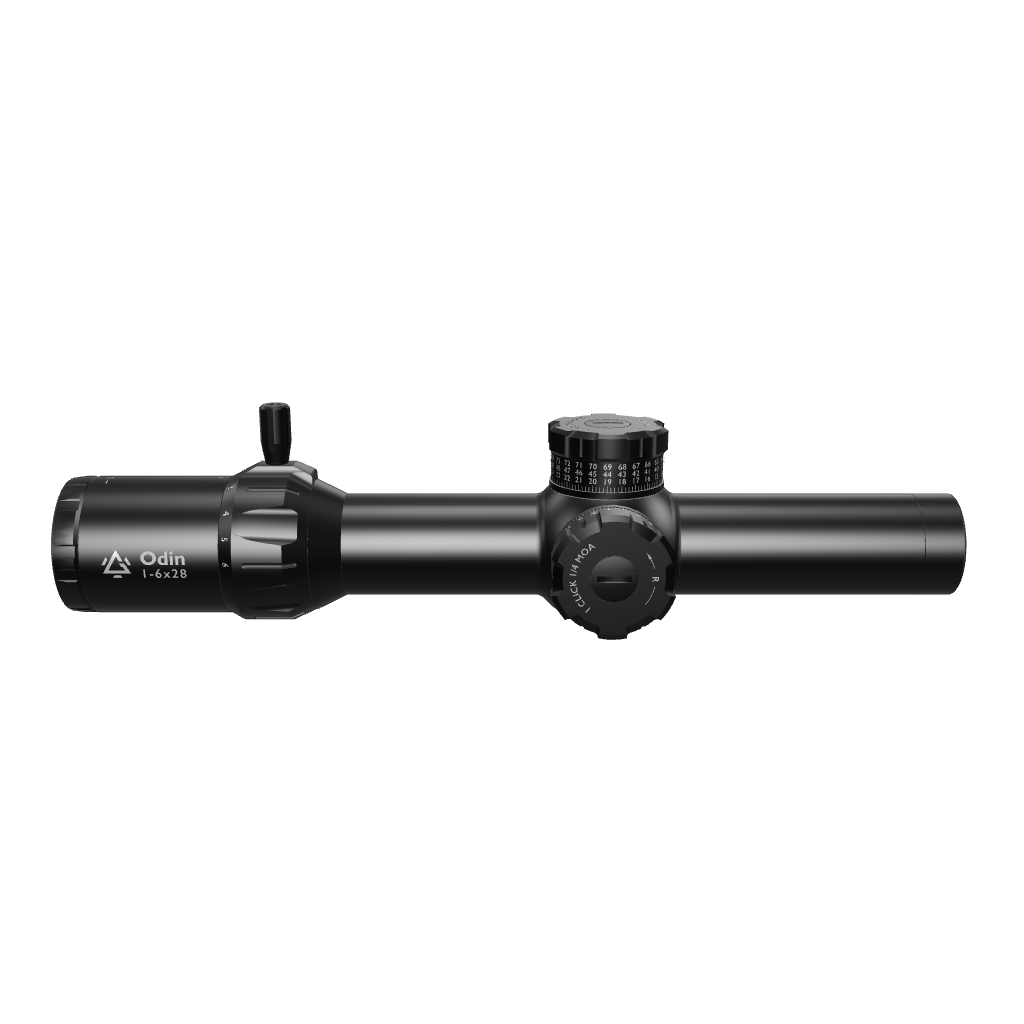MOA (Minute of Angle) in Shooting and How to Adjust Your Scope
In shooting, MOA stands for Minute of Angle (MOA), and it is a standardized method that helps shooters estimate and measure how accurate their optic is, determine the adjustments they need to make, and estimate the dimensions for different targets.
Just like a professional photographer knows how to adjust a camera's settings to get the right picture quality, a good shooter must master how to play with the adjustments on their rifle optic in order to obtain pinpoint accuracy even when on the run.
So, explore what MOA is, discuss some practical applications where MOA helps you perform spectacularly on the field, and explain how this helps you address common shooting scenarios.
What is MOA?
MOA stands for “Minute of Angle.” In shooting, MOA means 1/60th of a degree, and since there are 360 degrees in a circle, there are 21,600 minutes of angle (MOA) in a full circle.
“Minute” stands for 1/6th, just like one “minute” is “1/6th of an hour”. The “angle” refers to one of the 360 degrees in a full circle.
What is MOA on a Scope?
MOA on a scope helps you adjust your turrets so your rifle can hit the target accurately. Minute of Angle is a formula that helps you read the right signals on your scope, determine how far off your shots are, and what adjustments you need to make to hit the distant target.
-
If you know how many inches you are off by, you can calculate and convert the distance( in inches) to Minute of Angle(in degrees), then adjust your optic to the corresponding degrees.
-
MOA in shooting is crucial for hitting different targets across long distances. When the target is far off, MOA helps you account for and compensate for other intervening factors, such as bullet drop and wind drift.
How is MOA Used?
MOA is used for scope adjustments. A rifle scope is adjusted in MOA increments, typically ¼ MOA per click. This means for every click, your point of impact will move about ¼ inch at 100 yards.
MOA is used to measure how tight or spread out your shots are on a target. For instance, if you have a 1-inch group at 100 yards, your shot spread is about 1 MOA.
How MOA is Used in Practice
If your shot is 1 MOA off from your point of aim at 100 yards, the bullet will land about 1 inch away from the center.
At 500 yards, the same 1 MOA offset would result in a bullet landing approximately 5 inches away from where you aimed.
How to Calculate MOA
You can calculate the physical size of an MOA group or make adjustments at any distance using this formula:
MOA Size=Group Size (inches)Distance (yards)100
-
Group size refers to the biggest distance between your scattered shots
-
Distance refers to the distance between yourself and the target.
1MOA at 100 Yards
At 100 yards, 1 MOA equals approximately 1.047 inches. MOA is a unit of angular measurement, which means it spreads out over a distance.
Most shooters round 1MOA to 1 inch at 100 yards for convenience (the difference of 0.047 inches is mostly negligible). 200 yards, 1 MOA equals 2.094 inches, and at 300 yards, it’s 3.141 inches, and so on.
-
At 100 yards, 1 MOA ≈ 1.047 inches.
-
At 200 yards, 1 MOA ≈ 2.094 inches.
-
At 300 yards, 1 MOA ≈ 3.141 inches.
MOA on a Scope: How Many Clicks are there in an MOA?
The number of clicks in an MOA varies depending on the type of optic. Manufacturers make it very clear from the specs of their optics how many clicks make 1 MOA.
Most LPVO optics are 1/4 MOA, meaning you need four clicks to change 1 MOA, but some are 1 MOA, 1/2 MOA, or even 1/8 MOA.
-
1 MOA means one click moves the point of impact by 1 inch at 100 yards.
-
1/4 MOA means a click moves the point of impact is moved by 1/4th inch at 100 yards
-
1/8 MOA is common in precision optics and allows for even finer adjustments. The point of impact is moved by 1/8 inch at 100 yards.
What About Reticles with MOA Markings
If your optic has an MOA-based reticle, it will have hash marks or dots calibrated in MOA increments. These are really practical because they allow you to adjust for BDC or wind drift by using the reticle without adjusting turrets.
Example
Let’s say you are shooting at 600 yards, and your bullet drops 10 MOA.
All you have to do is align the 10 MOA hash mark on the reticle with the target instead of adjusting the elevation turret.
If a target at 600 yards is 18 inches tall, calculate its MOA, then use the reticle to estimate its size and range.
Using MOA: Practical Applications
MOA is Used to Adjust for Bullet Drop
Bullet drop is the natural downward trajectory of a bullet that is caused by gravity. Shooting at a distance means you have to measure and account for it. To adjust for bullet drop, use this formula:
-
Measure the drop. Find the distance (in inches) your bullet impacts below the target point.
-
Convert the drop from inches to MOA using this formula:
MOA=Error(inches)Distance (Yards)100
-
Adjust scope turrets: Most scopes allow elevation adjustments in MOA increments. For example, if your scope adjusts in 1/4 MOA clicks, multiply the required MOA by 4 to find the number of clicks.
MOA is Used to Adjust for Wind Drift
Wind drift is the horizontal movement of the bullet that is caused by wind. The adjustment process is similar to bullet drop:
-
Measure the drift: Determine how far the bullet impacts the left or right of the target.
-
Convert drift to MOA using the same formula:
MOA=Drift(inches)Distance (Yards)100
-
Adjust windage turrets and apply the calculated MOA to your scope’s windage turret.
Getting an MOA Optic
Understanding its principles and applying the calculations can improve your shooting accuracy and adaptability across distances and conditions.
Whether you’re hunting, target shooting, or engaging in competitive shooting, an MOA optic will always be a valuable asset, especially if you can get the right one.
ODIN LPVOs From Gogunnr: Pick the Right One!
Gogunnr’s Odin optics come in three models: the Odin 1-6x 28, Odin 1-8x 24 LPVO, and the Odin 1-10x 28 LPVO. These three Odin optics offer every possible magnification range within the capabilities of an LPVO, which makes them perfectly versatile for deer hunting.
7 Reasons To Check Out Gunnr’s MOA LPVOs
-
Gogunnr Odin scopes feature Bullet reticles with extended 1 MOA hash marks for precise windage and elevation adjustments. You can compensate for bullet drops at varying distances without even adjusting the scope's elevation turret.
-
They come with a cantilever mount, directly compatible with the Picatinny rails of most hunting rifles. You can use them with no additional adapters.
-
The lenses are made of German Schott glass, which gives clear image quality, even in low light, with no chromatic aberration.
-
Odin scopes generally weigh about (about 4.8×1.65×2.44 inches in size), making them just as lightweight and maneuverable for your hunting setup.
-
The exterior of each optic is made of 7075 aluminum alloy, which is durable and can withstand harsh hunting conditions.
-
They are all tested to withstand 1,000 impacts at 1,000G and 2,000 live-fire rounds.
-
They are also waterproof and fogproof. They are built to withstand temperatures from -59°F to 149°F and have an IP67 waterproofing rating.
Common MOA Questions Explained
1. How Many Inches is 1 MOA at Any Distance?
At 100 yards, 1 MOA equals 1.047 inches. For other distances, you can calculate the size in inches. Use this formula:
-
Inches per MOA = Distance (yards)×1.047÷100
Example At 800 yards: 800×1.047÷100=8.376 inches per MOA
2. How Do You Convert Group Size to MOA?
When evaluating your shooting accuracy, determine the group size by measuring the farthest distance between the bullet holes in the group. Then, convert this measurement unit to MOA using the following formula:
MOA=Group size(inches)Distance (Yards) 100
MOA vs. MIL (Milliradian)
MOA and MIL are two systems for angular measurement, and although they are both used to achieve the same purpose, they are different in many ways.
-
Where 1 MOA is 1.047 inches at 100 yards, 1MIL is 3.6 inches. MOA is measured in fractions while MIL is measured in decimals (Conversion: 1 MIL ≈ 3.438 MOA.
-
MOA is common in the United States, while MIL is common in Europe and the rest of the world.
Practical Tips for Using MOA
-
Understand Your Scope
Know the adjustment increments (is it 1 MOA or 1/4 MOA per click?). Practice using the reticle for holdovers.
-
Make sure your measurements are accurate
Use calipers or rulers to ensure the accuracy of group sizes and convert measurements to MOA to evaluate consistency.
-
Don’t forget to account for environmental factors
Bullet drop and wind drift are affected by range, wind speed, and bullet type. You can use ballistic calculators to gather precise data.
-
Practice Regularly
Apply MOA concepts in real-world shooting scenarios to build confidence. You can train at varying distances to understand how MOA scales.
More From Gunnr
Check out how other important tips on protecting your LPVO. If you own an AR-15, learn why the Gogunnr optic pairs perfectly with your AR-15.







